Layout management in wxPython
last modified January 10, 2023
A typical application consists of various widgets. Those widgets are placed inside container widgets. A programmer must manage the layout of the application. This is not an easy task. In wxPython it is possible to lay out widgets using absolute positioning or using sizers.
Absolute Positioning
The programmer specifies the position and the size of each widget in pixels. Absolute positioning has several disadvantages:
- The size and the position of a widget do not change if we resize a window.
- Applications look different on various platforms.
- Changing fonts in the application might spoil the layout.
- If we decide to change our layout, we must completely redo our layout, which is tedious and time consuming.
There might be situations where we can possibly use absolute positioning. For instance, small test examples. But mostly, in real world programs, programmers use sizers.
In our example we have a simple skeleton of a text editor. If we resize
the window, the size of out wx.TextCtrl does not change as
we would expect.
#!/usr/bin/env python
"""
ZetCode wxPython tutorial
In this example, we lay out widgets using
absolute positioning.
author: Jan Bodnar
website: www.zetcode.com
last modified: July 2020
"""
import wx
class Example(wx.Frame):
def __init__(self, parent, title):
super(Example, self).__init__(parent, title=title,
size=(350, 300))
self.InitUI()
self.Centre()
def InitUI(self):
self.panel = wx.Panel(self)
self.panel.SetBackgroundColour("gray")
self.LoadImages()
self.mincol.SetPosition((20, 20))
self.bardejov.SetPosition((40, 160))
self.rotunda.SetPosition((170, 50))
def LoadImages(self):
self.mincol = wx.StaticBitmap(self.panel, wx.ID_ANY,
wx.Bitmap("mincol.jpg", wx.BITMAP_TYPE_ANY))
self.bardejov = wx.StaticBitmap(self.panel, wx.ID_ANY,
wx.Bitmap("bardejov.jpg", wx.BITMAP_TYPE_ANY))
self.rotunda = wx.StaticBitmap(self.panel, wx.ID_ANY,
wx.Bitmap("rotunda.jpg", wx.BITMAP_TYPE_ANY))
def main():
app = wx.App()
ex = Example(None, title='Absolute positioning')
ex.Show()
app.MainLoop()
if __name__ == '__main__':
main()
In the above example, we position three images using absolute coordinates.
self.mincol.SetPosition((20, 20))
With the SetPosition() method we place the image at x=20, y=20
coordinates.
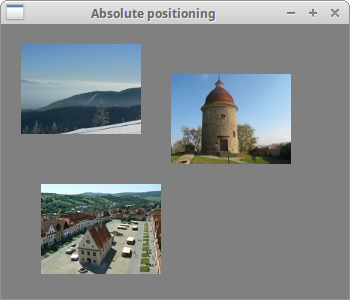
Using sizers
Sizers do address all those issues we mentioned by absolute positioning. wxPython has the following sizers:
- wx.BoxSizer
- wx.StaticBoxSizer
- wx.GridSizer
- wx.FlexGridSizer
- wx.GridBagSizer
wx.BoxSizer
wx.BoxSizer enables us to put several widgets into a row or a column.
We can put another sizer into an existing sizer. This way we can
create very complex layouts.
box = wx.BoxSizer(integer orient) box.Add(wx.Window window, integer proportion=0, integer flag = 0, integer border = 0)
The orientation can be wx.VERTICAL or wx.HORIZONTAL.
Adding widgets into the wx.BoxSizer is done via the Add()
method. In order to understand it, we need to look at its parameters.
The proportion parameter defines the ratio of how widgets change in the defined
orientation. Let's assume we have three buttons
with the proportions 0, 1, and 2. They are added into a horizontal
wx.BoxSizer. Button with proportion 0 will not change at all.
Button with proportion 2 will change twice more than the one
with proportion 1 in the horizontal dimension.
With the flag parameter you can further configure the behaviour of
the widgets within a wx.BoxSizer. We can control the border between
the widgets. We add some space between widgets in pixels. In order
to apply border we need to define sides, where the border will be
used. We can combine them with the | operator; for instance
wx.LEFT | wx.BOTTOM. We can choose between these flags:
- wx.LEFT
- wx.RIGHT
- wx.BOTTOM
- wx.TOP
- wx.ALL
The sizer is set to the panel widget with setSizer() method.
#!/usr/bin/env python
"""
ZetCode wxPython tutorial
In this example we place a panel inside
another panel.
author: Jan Bodnar
website: www.zetcode.com
last modified: July 2020
"""
import wx
class Example(wx.Frame):
def __init__(self, parent, title):
super(Example, self).__init__(parent, title=title)
self.InitUI()
self.Centre()
def InitUI(self):
panel = wx.Panel(self)
panel.SetBackgroundColour('#4f5049')
vbox = wx.BoxSizer(wx.VERTICAL)
midPan = wx.Panel(panel)
midPan.SetBackgroundColour('#ededed')
vbox.Add(midPan, wx.ID_ANY, wx.EXPAND | wx.ALL, 20)
panel.SetSizer(vbox)
def main():
app = wx.App()
ex = Example(None, title='Border')
ex.Show()
app.MainLoop()
if __name__ == '__main__':
main()
In the above example, we place some space around a panel.
vbox.Add(midPan, wx.ID_ANY, wx.EXPAND | wx.ALL, 20)
In border.py we have placed a 20 px border around a
midPan panel. wx.ALL applies the border
size to all four sides.
If we use wx.EXPAND flag, our widget will use all the space that
has been allotted to it. Lastly, we can also define the alignment
of our widgets. We do it with the following flags:
- wx.ALIGN_LEFT
- wx.ALIGN_RIGHT
- wx.ALIGN_TOP
- wx.ALIGN_BOTTOM
- wx.ALIGN_CENTER_VERTICAL
- wx.ALIGN_CENTER_HORIZONTAL
- wx.ALIGN_CENTER
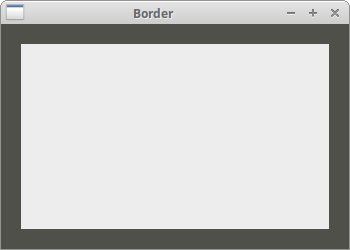
GoToClass example
In the following example we introduce several important ideas.
#!/usr/bin/env python
"""
ZetCode wxPython tutorial
In this example we create a Go To class
layout with wx.BoxSizer.
author: Jan Bodnar
website: www.zetcode.com
last modified: July 2020
"""
import wx
class Example(wx.Frame):
def __init__(self, parent, title):
super(Example, self).__init__(parent, title=title)
self.InitUI()
self.Centre()
def InitUI(self):
panel = wx.Panel(self)
font = wx.SystemSettings.GetFont(wx.SYS_SYSTEM_FONT)
font.SetPointSize(9)
vbox = wx.BoxSizer(wx.VERTICAL)
hbox1 = wx.BoxSizer(wx.HORIZONTAL)
st1 = wx.StaticText(panel, label='Class Name')
st1.SetFont(font)
hbox1.Add(st1, flag=wx.RIGHT, border=8)
tc = wx.TextCtrl(panel)
hbox1.Add(tc, proportion=1)
vbox.Add(hbox1, flag=wx.EXPAND|wx.LEFT|wx.RIGHT|wx.TOP, border=10)
vbox.Add((-1, 10))
hbox2 = wx.BoxSizer(wx.HORIZONTAL)
st2 = wx.StaticText(panel, label='Matching Classes')
st2.SetFont(font)
hbox2.Add(st2)
vbox.Add(hbox2, flag=wx.LEFT | wx.TOP, border=10)
vbox.Add((-1, 10))
hbox3 = wx.BoxSizer(wx.HORIZONTAL)
tc2 = wx.TextCtrl(panel, style=wx.TE_MULTILINE)
hbox3.Add(tc2, proportion=1, flag=wx.EXPAND)
vbox.Add(hbox3, proportion=1, flag=wx.LEFT|wx.RIGHT|wx.EXPAND,
border=10)
vbox.Add((-1, 25))
hbox4 = wx.BoxSizer(wx.HORIZONTAL)
cb1 = wx.CheckBox(panel, label='Case Sensitive')
cb1.SetFont(font)
hbox4.Add(cb1)
cb2 = wx.CheckBox(panel, label='Nested Classes')
cb2.SetFont(font)
hbox4.Add(cb2, flag=wx.LEFT, border=10)
cb3 = wx.CheckBox(panel, label='Non-Project classes')
cb3.SetFont(font)
hbox4.Add(cb3, flag=wx.LEFT, border=10)
vbox.Add(hbox4, flag=wx.LEFT, border=10)
vbox.Add((-1, 25))
hbox5 = wx.BoxSizer(wx.HORIZONTAL)
btn1 = wx.Button(panel, label='Ok', size=(70, 30))
hbox5.Add(btn1)
btn2 = wx.Button(panel, label='Close', size=(70, 30))
hbox5.Add(btn2, flag=wx.LEFT|wx.BOTTOM, border=5)
vbox.Add(hbox5, flag=wx.ALIGN_RIGHT|wx.RIGHT, border=10)
panel.SetSizer(vbox)
def main():
app = wx.App()
ex = Example(None, title='Go To Class')
ex.Show()
app.MainLoop()
if __name__ == '__main__':
main()
The layout is straitforward. We create one vertical sizer. We put then five horizontal sizers into it.
font = wx.SystemSettings.GetFont(wx.SYS_SYSTEM_FONT) font.SetPointSize(9)
We change the font size to 9 px.
vbox.Add(hbox3, proportion=1, flag=wx.LEFT|wx.RIGHT|wx.EXPAND,
border=10)
vbox.Add((-1, 25))
We already know that we can control the distance among widgets by
combining the flag parameter with the border parameter. But there is one
real constraint. In the Add() method we can specify only one border
for all given sides. In our example, we give 10 px to the right and to the
left. But we cannot give 25 px to the bottom. What we can do is to give
10 px to the bottom, or 0 px if we omit wx.BOTTOM.
So if we need different values, we can add some extra space.
With the Add() method, we can insert widgets and space as well.
vbox.Add(hbox5, flag=wx.ALIGN_RIGHT|wx.RIGHT, border=10)
We place the two buttons on the right side of the window. Three things are
important to achieve this: the proportion, the align flag, and the
wx.EXPAND flag. The proportion must be zero.
The buttons should not change their size when we resize our window.
We must not specify wx.EXPAND flag. The buttons occopy only the area
that has been alotted to them. And finally, we must specify the
wx.ALIGN_RIGHT flag. The horizontal sizer spreads from the left
side of the window to the right side. So if we specify wx.ALIGN_RIGHT
flag, the buttons are placed to the right side.
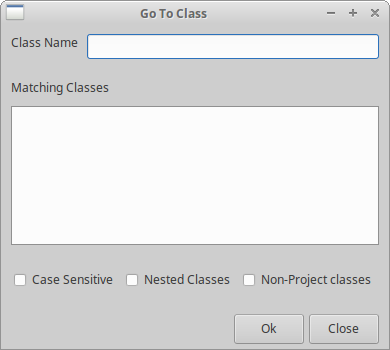
wx.GridSizer
The wx.GridSizer lays out widgets in two dimensional table.
Each cell within the table has the same size.
wx.GridSizer(int rows=1, int cols=0, int vgap=0, int hgap=0)
In the constructor we specify the number of rows and columns in the table and the vertical and horizontal space between our cells.
In our example we create a skeleton of a calculator.
#!/usr/bin/env python
"""
ZetCode wxPython tutorial
In this example we create a layout
of a calculator with wx.GridSizer.
author: Jan Bodnar
website: www.zetcode.com
last modified: July 2020
"""
import wx
class Example(wx.Frame):
def __init__(self, parent, title):
super(Example, self).__init__(parent, title=title)
self.InitUI()
self.Centre()
def InitUI(self):
menubar = wx.MenuBar()
fileMenu = wx.Menu()
menubar.Append(fileMenu, '&File')
self.SetMenuBar(menubar)
vbox = wx.BoxSizer(wx.VERTICAL)
self.display = wx.TextCtrl(self, style=wx.TE_RIGHT)
vbox.Add(self.display, flag=wx.EXPAND|wx.TOP|wx.BOTTOM, border=4)
gs = wx.GridSizer(5, 4, 5, 5)
gs.AddMany( [(wx.Button(self, label='Cls'), 0, wx.EXPAND),
(wx.Button(self, label='Bck'), 0, wx.EXPAND),
(wx.StaticText(self), wx.EXPAND),
(wx.Button(self, label='Close'), 0, wx.EXPAND),
(wx.Button(self, label='7'), 0, wx.EXPAND),
(wx.Button(self, label='8'), 0, wx.EXPAND),
(wx.Button(self, label='9'), 0, wx.EXPAND),
(wx.Button(self, label='/'), 0, wx.EXPAND),
(wx.Button(self, label='4'), 0, wx.EXPAND),
(wx.Button(self, label='5'), 0, wx.EXPAND),
(wx.Button(self, label='6'), 0, wx.EXPAND),
(wx.Button(self, label='*'), 0, wx.EXPAND),
(wx.Button(self, label='1'), 0, wx.EXPAND),
(wx.Button(self, label='2'), 0, wx.EXPAND),
(wx.Button(self, label='3'), 0, wx.EXPAND),
(wx.Button(self, label='-'), 0, wx.EXPAND),
(wx.Button(self, label='0'), 0, wx.EXPAND),
(wx.Button(self, label='.'), 0, wx.EXPAND),
(wx.Button(self, label='='), 0, wx.EXPAND),
(wx.Button(self, label='+'), 0, wx.EXPAND) ])
vbox.Add(gs, proportion=1, flag=wx.EXPAND)
self.SetSizer(vbox)
def main():
app = wx.App()
ex = Example(None, title='Calculator')
ex.Show()
app.MainLoop()
if __name__ == '__main__':
main()
Notice how we managed to put a space between the Bck and the
Close buttons. We simply put an empty wx.StaticText there.
In our example we have used the AddMany() method. It is a
convenience method for adding multiple widgets at one time.
gs.AddMany( [(wx.Button(self, label='Cls'), 0, wx.EXPAND), ...
Widgets are placed inside the table in the order, they are added. The first row is filled first, then the second row etc.
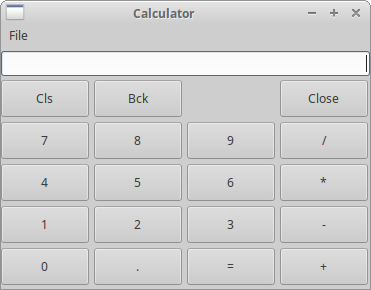
wx.FlexGridSizer
This sizer is similar to wx.GridSizer. It does also lay out
its widgets in a two dimensional table. It adds some flexibility to it.
wx.GridSizer cells are of the same size. All cells in
wx.FlexGridSizer have the same height in a row. All cells have
the same width in a column. But all rows and columns are not necessarily the
same height or width.
wx.FlexGridSizer(int rows=1, int cols=0, int vgap=0, int hgap=0)
rows and cols specify the number of rows and columns in a sizer.
vgap and hgap add some space between widgets in both directions.
Many times developers have to develop dialogs for data input and modification.
I find wx.FlexGridSizer suitable for such a task. A developer can easily
set up a dialog window with this sizer. It is also possible to accomplish this
with wx.GridSizer, but it would not look nice, because of the constraint
that each cell must have the same size.
#!/usr/bin/env python
"""
ZetCode wxPython tutorial
In this example we create review
layout with wx.FlexGridSizer.
author: Jan Bodnar
website: www.zetcode.com
last modified: July 2020
"""
import wx
class Example(wx.Frame):
def __init__(self, parent, title):
super(Example, self).__init__(parent, title=title)
self.InitUI()
self.Centre()
self.Show()
def InitUI(self):
panel = wx.Panel(self)
hbox = wx.BoxSizer(wx.HORIZONTAL)
fgs = wx.FlexGridSizer(3, 2, 9, 25)
title = wx.StaticText(panel, label="Title")
author = wx.StaticText(panel, label="Author")
review = wx.StaticText(panel, label="Review")
tc1 = wx.TextCtrl(panel)
tc2 = wx.TextCtrl(panel)
tc3 = wx.TextCtrl(panel, style=wx.TE_MULTILINE)
fgs.AddMany([(title), (tc1, 1, wx.EXPAND), (author),
(tc2, 1, wx.EXPAND), (review, 1, wx.EXPAND), (tc3, 1, wx.EXPAND)])
fgs.AddGrowableRow(2, 1)
fgs.AddGrowableCol(1, 1)
hbox.Add(fgs, proportion=1, flag=wx.ALL|wx.EXPAND, border=15)
panel.SetSizer(hbox)
def main():
app = wx.App()
ex = Example(None, title='Review')
ex.Show()
app.MainLoop()
if __name__ == '__main__':
main()
In the above code example, we create a Review window with a
FlexGridSizer.
hbox = wx.BoxSizer(wx.HORIZONTAL) ... hbox.Add(fgs, proportion=1, flag=wx.ALL|wx.EXPAND, border=15)
We create a horizontal box sizer in order to put some space (15 px) around the table of widgets.
fgs.AddMany([(title), (tc1, 1, wx.EXPAND), (author),
(tc2, 1, wx.EXPAND), (review, 1, wx.EXPAND), (tc3, 1, wx.EXPAND)])
We add widgets to the sizer with the AddMany() method.
Both wx.FlexGridSizer and wx.GridSizer share
this method.
fgs.AddGrowableRow(2, 1) fgs.AddGrowableCol(1, 1)
We make the third row and second column growable. This way we let the
text controls grow when the window is resized. The first two text
controls will grow in horizontal direction, the third one will
grow in both directions. We must not forget to make the widgets
expandable with wx.EXPAND in order to make it work.
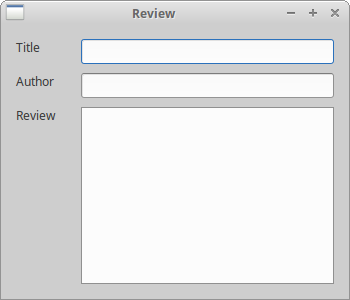
wx.GridBagSizer
wx.GridBagSizer is the most flexible sizer in wxPython.
to use. This kind of sizer is not typical only for wxPython. We can
find it in other toolkits as well.
This sizer enables explicit positioning of items. Items can also optionally
span more than one row or column. The wx.GridBagSizer
has a simple constructor.
wx.GridBagSizer(integer vgap, integer hgap)
The vertical and the horizontal gap defines the space in pixels used
among all children. We add items to the grid with the Add() method.
Add(self, item, tuple pos, tuple span=wx.DefaultSpan, integer flag=0,
integer border=0, userData=None)
Item is a widget that you insert into the grid. The pos specifies the position
in the virtual grid. The top-left cell has pos of (0, 0). The span is an optional
spanning of the widget; e.g. a span of (3, 2) spans a widget across 3 rows
and 2 columns. The flag and border were discussed earlier by wx.BoxSizer.
The items in the grid can change their size or keep the default size,
when the window is resized. If we want your items to grow and shrink,
we can use the following two methods:
AddGrowableRow(integer row) AddGrowableCol(integer col)
Rename window example
In our first example, we create a Rename window. It will have one
wx.StaticText, one wx.TextCtrl and two
wx.Button widgets.
#!/usr/bin/env python
"""
ZetCode wxPython tutorial
In this example we create a rename layout
with wx.GridBagSizer.
author: Jan Bodnar
website: www.zetcode.com
last modified: July 2020
"""
import wx
class Example(wx.Frame):
def __init__(self, parent, title):
super(Example, self).__init__(parent, title=title)
self.InitUI()
self.Centre()
def InitUI(self):
panel = wx.Panel(self)
sizer = wx.GridBagSizer(4, 4)
text = wx.StaticText(panel, label="Rename To")
sizer.Add(text, pos=(0, 0), flag=wx.TOP|wx.LEFT|wx.BOTTOM, border=5)
tc = wx.TextCtrl(panel)
sizer.Add(tc, pos=(1, 0), span=(1, 5),
flag=wx.EXPAND|wx.LEFT|wx.RIGHT, border=5)
buttonOk = wx.Button(panel, label="Ok", size=(90, 28))
buttonClose = wx.Button(panel, label="Close", size=(90, 28))
sizer.Add(buttonOk, pos=(3, 3))
sizer.Add(buttonClose, pos=(3, 4), flag=wx.RIGHT|wx.BOTTOM, border=10)
sizer.AddGrowableCol(1)
sizer.AddGrowableRow(2)
panel.SetSizer(sizer)
def main():
app = wx.App()
ex = Example(None, title='Rename')
ex.Show()
app.MainLoop()
if __name__ == '__main__':
main()
We must look at the window as a one big grid table.
text = wx.StaticText(panel, label="Rename To") sizer.Add(text, pos=(0, 0), flag=wx.TOP|wx.LEFT|wx.BOTTOM, border=10)
The text "Rename to" goes to the left upper corner. So we specify the (0, 0) position. And we add some space to the bottom, left, and bottom.
tc = wx.TextCtrl(panel)
sizer.Add(tc, pos=(1, 0), span=(1, 5),
flag=wx.EXPAND|wx.LEFT|wx.RIGHT, border=5)
The wx.TextCtrl goes to the beginning of the second row (1, 0). Remember,
that we count from zero. It expands 1 row and 5 columns (1, 5). And we put
5 pixels of space to the left and to the right of the widget.
sizer.Add(buttonOk, pos=(3, 3)) sizer.Add(buttonClose, pos=(3, 4), flag=wx.RIGHT|wx.BOTTOM, border=10)
We put two buttons into the fourth row. The third row is left empty, so
that we have some space between the wx.TextCtrl and the buttons. We put the
OK button into the fourth column and the Close button into the fifth one.
Notice that once we apply some space to one widget, it is applied to the
whole row. That's why we did not specify bottom space for the OK button.
A careful reader might notice that we did not specify any space between
the two buttons; that is, we did not put any space to the right of the OK button,
or to the right of the Close button. In the constructor of the wx.GridBagSizer,
we put some space between all widgets. So there is some space already.
sizer.AddGrowableCol(1) sizer.AddGrowableRow(2)
The last thing we must do is to make our dialog resizable. We make the second column and the third row growable. Now we can expand or shrink our window. Try to comment those two lines and see what happens.

New class example
In the next example is we create a window, which can be found in JDeveloper. It is a window for creating a new class in Java.
#!/usr/bin/env python
"""
ZetCode wxPython tutorial
In this example we create a new class layout
with wx.GridBagSizer.
author: Jan Bodnar
website: www.zetcode.com
last modified: July 2020
"""
import wx
class Example(wx.Frame):
def __init__(self, parent, title):
super(Example, self).__init__(parent, title=title)
self.InitUI()
self.Centre()
def InitUI(self):
panel = wx.Panel(self)
sizer = wx.GridBagSizer(5, 5)
text1 = wx.StaticText(panel, label="Java Class")
sizer.Add(text1, pos=(0, 0), flag=wx.TOP|wx.LEFT|wx.BOTTOM,
border=15)
icon = wx.StaticBitmap(panel, bitmap=wx.Bitmap('exec.png'))
sizer.Add(icon, pos=(0, 4), flag=wx.TOP|wx.RIGHT|wx.ALIGN_RIGHT,
border=5)
line = wx.StaticLine(panel)
sizer.Add(line, pos=(1, 0), span=(1, 5),
flag=wx.EXPAND|wx.BOTTOM, border=10)
text2 = wx.StaticText(panel, label="Name")
sizer.Add(text2, pos=(2, 0), flag=wx.LEFT, border=10)
tc1 = wx.TextCtrl(panel)
sizer.Add(tc1, pos=(2, 1), span=(1, 3), flag=wx.TOP|wx.EXPAND)
text3 = wx.StaticText(panel, label="Package")
sizer.Add(text3, pos=(3, 0), flag=wx.LEFT|wx.TOP, border=10)
tc2 = wx.TextCtrl(panel)
sizer.Add(tc2, pos=(3, 1), span=(1, 3), flag=wx.TOP|wx.EXPAND,
border=5)
button1 = wx.Button(panel, label="Browse...")
sizer.Add(button1, pos=(3, 4), flag=wx.TOP|wx.RIGHT, border=5)
text4 = wx.StaticText(panel, label="Extends")
sizer.Add(text4, pos=(4, 0), flag=wx.TOP|wx.LEFT, border=10)
combo = wx.ComboBox(panel)
sizer.Add(combo, pos=(4, 1), span=(1, 3),
flag=wx.TOP|wx.EXPAND, border=5)
button2 = wx.Button(panel, label="Browse...")
sizer.Add(button2, pos=(4, 4), flag=wx.TOP|wx.RIGHT, border=5)
sb = wx.StaticBox(panel, label="Optional Attributes")
boxsizer = wx.StaticBoxSizer(sb, wx.VERTICAL)
boxsizer.Add(wx.CheckBox(panel, label="Public"),
flag=wx.LEFT|wx.TOP, border=5)
boxsizer.Add(wx.CheckBox(panel, label="Generate Default Constructor"),
flag=wx.LEFT, border=5)
boxsizer.Add(wx.CheckBox(panel, label="Generate Main Method"),
flag=wx.LEFT|wx.BOTTOM, border=5)
sizer.Add(boxsizer, pos=(5, 0), span=(1, 5),
flag=wx.EXPAND|wx.TOP|wx.LEFT|wx.RIGHT , border=10)
button3 = wx.Button(panel, label='Help')
sizer.Add(button3, pos=(7, 0), flag=wx.LEFT, border=10)
button4 = wx.Button(panel, label="Ok")
sizer.Add(button4, pos=(7, 3))
button5 = wx.Button(panel, label="Cancel")
sizer.Add(button5, pos=(7, 4), span=(1, 1),
flag=wx.BOTTOM|wx.RIGHT, border=10)
sizer.AddGrowableCol(2)
panel.SetSizer(sizer)
sizer.Fit(self)
def main():
app = wx.App()
ex = Example(None, title="Create Java Class")
ex.Show()
app.MainLoop()
if __name__ == '__main__':
main()
This is a more complicated layout. We use both a wx.GridBagSizer and
a wx.StaticBoxsizer.
line = wx.StaticLine(panel)
sizer.Add(line, pos=(1, 0), span=(1, 5),
flag=wx.EXPAND|wx.BOTTOM, border=10)
This is a line that is used to separate groups of widgets in the layout.
icon = wx.StaticBitmap(panel, bitmap=wx.Bitmap('exec.png'))
sizer.Add(icon, pos=(0, 4), flag=wx.TOP|wx.RIGHT|wx.ALIGN_RIGHT,
border=5)
We put an wx.StaticBitmap into the first row of the grid.
We place it on the right side of the row.
sb = wx.StaticBox(panel, label="Optional Attributes") boxsizer = wx.StaticBoxSizer(sb, wx.VERTICAL)
wxStaticBoxSizer is like a normal wx.BoxSizer but
it adds a static box around the sizer. We put check boxes into the static box sizer.

This part of the wxPython tutorial was dedicated to layout management.